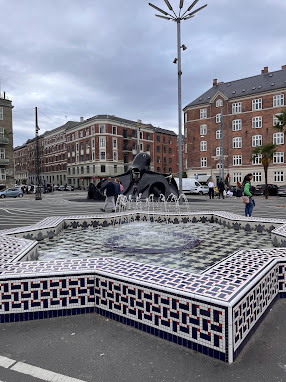Interests and Questions
In Copenhagen, a bicycle is the most important form of transportation. Cycling offers cheap, healthy, and eco-friendly ways to move, and it is often the fastest means of transport around Copenhagen. Bikes are an integral part of life in Copenhagen, and people who live here use their bikes for almost everything, to work, school, social events, and running errands.
While biking throughout Copenhagen, I have not noticed people wearing safety gear. There are a good handful of people, generally women, wearing inflatable helmets (inflate/go off on impact), which is interesting to see. I wonder why people here use those instead of the typical helmets seen in the US. Last night I saw the first reflective ankle bands that also keep pant legs from catching on the bicycle. The lack of safety gear shows how safe and easy it is to bike here. Most bikes here are made for commuting, with fenders, plastic separating your leg and the gears/spokes, wide and comfortable seats, and handlebars placing the rider in an upright position. With bikes like this and the large connected and safe network of bike lanes, it is safe enough to bike here without helmets and reflective gear, especially because cars are used to driving around cyclists. Most of the cyclists I see with gear look like long-distance road bikers that are coming or going from the city. When I do see what looks like an average commuter with an inflatable helmet or reflective gear it makes me wonder if they are from the area or not, or if they have had a previous accident or felt a lack of safety while biking.
I am interested in comparing the infrastructure catered towards kids throughout the countries we’re going to. I have been so impressed with the playgrounds, in amount, simplicity, and uniqueness. I would like to observe the way kids who have grown up biking interact with each other, their environment, their family, etc. and how that may be different from many of the kids we see today who have never been able to explore their cities by themselves. A question I asked previously in my pre-assignment, that I am still wondering is are Danish children able to problem-solve better or are more independent due to their ability to travel/commute on their own at a younger age than American children. I am hoping to ask some parents or kids about their experiences and way of life before I leave Copenhagen.
I am interested in learning how easy it is to implement policy abound cycling, or what policy is required or not. In a lot of instances, it seems like simple infrastructure is just created or put in without requirements to follow. For example, there are a lot of small ‘ramps’ from the bike lane to the sidewalk, where asphalt was placed to connect cyclists to an area they previously wanted to go to and were unable to without stopping and getting off their bike. I wish it was that easy in the US, just pouring a bit of asphalt to connect a road to a sidewalk. Why can’t it be? Why do all these ‘simple’ changes need to be met with rules and policies that make them inaccessible?
Tomorrow we're heading to Malmo, Sweden so I'm interested in seeing the difference in bicycle infrastructure there. I have heard that Sweden is much less focused on bicycle infrastructure than Denmark, but I am excited about a smaller city, closer to some more natural areas.






Comments
Post a Comment